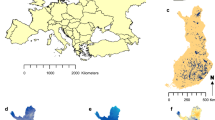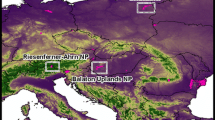Abstract
To estimate the magnitude of climate change anticipated forCanada's 38 National Parks (NPs) and Park Reserves, seasonaltemperature and precipitation scenarios were constructed for 2050and 2090 using the Canadian Centre for Climate Modelling andAnalysis (CCCma) coupled model (CGCM1). For each park, we assessed impacts on physical systems, species, ecosystems andpeople. Important, widespread changes relate to marine andfreshwater hydrology, glacial balance, waning permafrost, increased natural disturbance, shorter ice season, northern andupward altitudinal species and biome shifts, and changed visitation patterns. Other changes are regional (e.g., combinedEast coast subsidence and sea level rise increase coastal erosionand deposition, whereas, on the Pacific coast, tectonic upliftnegates sea level rise). Further predictions concern individualparks (e.g., Unique fens of Bruce Peninsular NP will migratelakewards with lowered water levels, but structural regulation of Lake Huron for navigation and power generation would destroythe fens). Knowledge gaps are the most important findings. Forexample: we could not form conclusions about glacial massbalance, or its effects on rivers and fjords. Likewise, for theEast Coast Labrador Current we could neither estimate temperature and salinity effects of extra iceberg formation, nor the further effects on marine food chains, and breeding park seabirds. We recommend 1) Research on specific large knowledge gaps; 2) Climate change information exchange with protected area agencies in other northern countries; and 3) incorporating climate uncertainty into park plans and management. We discuss options for a new park management philosophy in the face of massive change and uncertainty.
Similar content being viewed by others
References
Agriculture and Agri-Food Canada: 1997, Canadian Ecodistrict Climate Normals (1961–1990), GIS database, http://res.agr.ca/CANSIS/NSDB/ECOSTRAT/DISTRICT/climate.html.
Anderson, J. C., Craine, I., Diamond, A. W. and Hansell, R.: 1998, ‘Impacts of Climate Change and Variability on Unmanaged Ecosystems, Biodiversity and Wildlife’, in G. Koshida and W. Avis (eds), National Sectoral Volume, Canada Country Study: Climate Impacts and Adaptation: Volume VII, Environment Canada, Toronto.
Barry, R. and Maslanik, J.: 1992, ‘Monitoring Lake Freeze-up and Breakup as a Climatic Index’, in R. Barry, B. Goodison and E. LeDrew (eds), Snow Watch' 92: Detection Strategies for Snow and Ice, U.S. Department of Congress, Washington, pp. 66–76.
Boer, G. J.: 1999, ‘Climate Model Intercomparison, Chapter 19’, in Numerical modelling of the Global Atmosphere, Kluwer Academic Publishers.
Boer, G., Flato, G. and Ramsden, D. A.: ‘Transient climate change simulation with historical and projected greenhouse gas and aerosol forcing: Projected climate for the 21st century’ ,Climate Dynamics 16, 427–450.
Bridgewater, P. C.: 1991, ‘Impacts of climatic change on protected area management’ ,Environ. Profess. 13, 74–78.
Bridgewater, P. C.: 1996, ‘Protected area management in the face of climatic change’ ,Parks 6, 4–13.
Canadian Climate Program Board: 1998, Understanding and Adapting to Climate Change: A Canadian Perspective, Foundation Paper prepared for Climate Science, Impacts, and Adaptation, Canada's National Implementation Strategy, Canadian Climate Program Board, Ottawa.
Carter, T., Parry, M., Nishioka, S, and Harasawa, H.: 1994, IPCC Technical Guidelines for Assessing Climate Change Impacts and Adaptations, University College London and Centre for Global Environmental Studies, London, U.K.
Clair, T., Ehrman, J. and Higuchi, K.: 1998, ‘Changes to the runoff of Canadian ecozones under a doubled CO2 atmosphere’ ,Can. J. Fish. Aqua. Sci. 55, 2464–2477.
Environment Canada, Climate Change and Canadian Impacts: 1991, ‘The Scientific Perspective’ ,Climate Change Digest 89–2, Minister of Supply and Services, Ottawa.
Environment Canada: 1998, The Canada Country Study: Climate Impacts and Adaptation – National Summary for Policy Makers, Environment Canada, Toronto.
Etkin, D., Paoli, G. and Riseborough, D.: 1998, Climate Change Impacts of Permafrost Engineering Design, Environmental Adaptation Research Group, Environment Canada, Toronto.
Foot, D.: 1999, ‘The age of outdoor recreation in Canada’ ,Recr. Canada 56, 16–22.
Gomer, T.: 1990, Species Sensitivity to Climate Change in the Kejimkujik National Park Region, Unpublished Masters of Environmental Studies Thesis, Dalhousie University, Halifax.
Holdridge, L.: 1947, ‘Determination of world plant formation from simple climatic data’ ,Science 105, 367–368.
Hui, B.: 2000, ‘Ecosystem Impact of Climate Change on the Riding Mountain National Park Region and Its Implications for RMNP's Ecosystem Conservation Plan’ ,Unpublished Masters Thesis, School Planning, University of Waterloo, Waterloo.
Intergovernmental Panel on Climate Change (IPCC): 1994, Radiative Forcing of Climate Change and an Evaluation of the IPCC IS92 Emission Scenarios, Cambridge University Press, Cambridge.
Intergovernmental Panel on Climate Change (IPCC): 1995, IPCC Second Assessment – Climate Change 1995, Synthesis Report and Summaries for Policymakers, WMO, United Nations Environment Program, Geneva.
Kadonaga, L.: 1997, ‘Forecasting Future Fire Susceptibility in the Mackenzie Basin’, in S. J. Cohen (ed.), Mackenzie Basin Impact Study: Final Report, Minister of Supply and Services, Ottawa.
Kay, J. and Schneider, E.: 1992, ‘Thermodynamics and Measures of Ecological Integrity’, in D. McKenzie, D. Hyatt and V. McDonald (eds), Ecological Indicators, Elsevier Applied Science, New York.
Hill, N. M., Keddy, P. A. and Wisheu, I. C.: 1998, ‘A hydrological model for predicting the effects of dams on the shoreline vegetation of lakes and reservoirs’ ,Environ. Manage. 22, 723–726.
Lenihan, J. and Neilson, R.: 1995, ‘Canadian vegetation sensitivity to projected climatic change at three organizational levels’ ,Clim. Change, 30, 27–56.
Leopold, A. S., Cain, S. A., Cottam, C. M., Gabrielson, I. N. and Kimball, T. L.: 1963, Wildlife Management in the National Parks, U.S. Department of the Interior, Washington.
Lopoukhine, N.: 1990, ‘National Parks, Ecological Integrity and Climatic Change’, in G. Wall and M. Sanderson (eds), Climatic Change: Implications for Water and Ecological Resources, Department of Geography Publication Series, Occasional Paper No. 11, University of Waterloo, Waterloo.
Lopoukhine, N.: 1991, ‘The Role of Canada's National Parks in a Changed Climate’, in G. Wall (ed.), Symposium on the Impacts of Climatic Change and Variability on the Great Plains, Department of Geography Publication Series, Occasional Paper No. 12, University of Waterloo, Waterloo.
Macdonald, G., Edwards, T., Moser, K., Pienitz, R. and Smol, J.: 1993, ‘Rapid response of treeline vegetation and lakes to past climate warming’ ,Nature 361, 243–246.
Malcolm, J. and Markham, A.: 1996, ‘Ecosystem resilience, biodiversity and climate change: setting limits’ ,Parks 6, 38–49.
Manabe, S., Stouffer, R., Spelman, M. and Bryan, K.: 1991, ‘Transient responses of a coupled oceanatmosphere model to gradual changes of atmospheric CO2 – Part 1: Annual mean response’ ,J. Climate 4, 785–818.
Meisner, J. D.: 1990, ‘Effect of climate warming on the southern margins of the native range of brook trout, Salvelinus fontinalis’ ,Can. J. Fish. Aquat. Sci. 47, 1065–1070.
Moreland, A.: 1997, Forest Fire Management Plan: Bruce Peninsula National Park/Fathom Five National Marine Park, Parks Canada, Ottawa.
Mortsch, L.: 1999, Climate Change Impacts on Hydrology, Water Resources Management and the People of the Great Lakes – St. Lawrence System: A Technical Survey, A Report for the IJC Reference on Consumption, Diversions and Removals of Great Lakes Water, Environment Canada, Toronto.
Myers, N.: 1995, ‘Environmental unknowns’ ,Science 269, 358–360.
National and Historic Sites Branch: 1971, National Parks Systems Planning Manual, Supply and Services Canada, Ottawa.
Parks Canada: 1994, Guiding Principles and Operating Policies, Hull.
Parks Canada: 1998, State of the Parks 1997 Report, Parks Canada, Ottawa.
Parry, M. and Carter, T.: 1998, Climate Impact and Adaptation Assessment, Earthscan, London.
Pearman, G.: 1988, Greenhouse, CSIRO, Melbourne.
Pernetta, J., Leemans, R., Elder, D. and Humphrey, S. (eds): 1994, Impact of Climate Change on Ecosystems and Species: Implications for Protected Areas, International Union for Conservation of Nature and Natural Reserves, Gland.
Peters, R. and Darling, J.: 1985, ‘The greenhouse effect and nature reserves’ ,BioScience 35, 707–716.
Ritchie, J.: 1987, Postglacial Vegetation of Canada, Cambridge University Press, Cambridge, U.K.
Rizzo, B. and Wiken, E.: 1992, ‘Assessing the sensitivity of Canada's ecosystems to climatic change’ ,Clim. Change 21, 37–55.
Rowe, S.: 1989, National Parks and Climate Change: Notes for a Talk Given to Canadian Parks Service Personnel in Ottawa, Occasional Paper No. 4, National Parks Branch, Canadian Parks Service, Environment Canada, Ottawa.
Scott, D. S. and Suffling, R. (eds): 2000, Climate Change and Canada's National Park System: A Screening Level Assessment, Report prepared for Parks Canada (Department of Heritage) by the Adaptation and Impacts Research Group, Environment Canada and the Faculty of Environmental Studies, University of Waterloo, Waterloo (available at: www.tor.ec.gc.ca/airg).
Smith, J., Lavender, B., Auld, H., Broadhurst, D. and Bullock, T.: 1998, Climate Variability and Change in Ontario, Canada Country Study: Climate Impacts and Adaptation: Volume IV, Environment Canada, Ottawa.
Solomon, A.: 1994, ‘Management of Terrestrial Parks and Reserves During Climate Change’, in J. Pernetta, R. Leemans, D. Elder and S. Humphrey (eds), Impact of Climate Change on Ecosystems and Species: Implications for Protected Areas, International Union for Conservation of Nature and Natural Reserves, Gland, Switzerland.
Staple, T.: 1994, ‘Climate Change and Recreation in a Northern National Park’ ,Unpublished Masters Thesis, Department of Geography, University of Waterloo, Waterloo.
Stone, D.: ‘Impacts of climatic change on selected ecosystems in Europe’ ,Parks 6, 25–37.
Suffling, R.: 1991, ‘Wildland Forest Management and Landscape Diversity in the Boreal Forest of Northwestern Ontario During an Era of Climatic Warming’, in S. C. Nodvin and A. Thomas (eds), Fire and the Environment: Ecological and Cultural Perspectives: Proceedings of an International Symposium, General Technical Report SE-69, U.S. Department of Agriculture, Forest Service, Southeastern Forest Experimental Station, Asheville.
Suffling, R.: 1995, ‘Can disturbance determine vegetation distribution during climate warming?: A boreal test’ ,J. Biogeo. 22, 501–508.
Suffling, R., Clarke, T., Evans, M., Lamb, L., May, S., McKenzie, I. and Ramunas, A.: 1995, Vegetation Change and Vegetation Management in the Bruce Peninsula National Park and Environs, Final Report concerning Parks Canada Award 2379501, Faculty of Environmental Studies, University of Waterloo, Waterloo.
Thompson, I. D., Flannigan, M. D., Wotton, B. M. and Suffling, R.: 1998, ‘The effects of climate change on landscape diversity: an example in Ontario forests’ ,Environ. Monit. Assess. 49, 213–233.
United Nations: 1997, ‘English Conference of the Parties, Third Session, Kyoto, 1–10 December’ ,Kyoto Protocol to the United Nations Framework Convention on Climate Change, New York.
Wall, G. and Vetsch, J.: 1989, ‘The Implications of CO2 Induced Climatic Change for Prince Albert National Park, Saskatchewan. Repercussions du changement climatique sur le parc national de Prince Albert, Saskatchewan’, Canada Department of the Environment Canadian Climate Centre Climate Change Digest 89–03, Downsview.
Wall, G.: 1998, ‘Impacts of Climate Change on Recreation and Tourism’, in G. Koshida and W. Avis (eds), National Sectoral Volume, Canada Country Study: Climate Impacts and Adaptation: Volume VII, Environment Canada, Toronto.
Wein, R., Hogenbirk, J., McFarlane, B., Schwartz, A. and Wright, R.: 1990, ‘Protection strategies for parks under predicted climate change’ ,Parks 1, 17–21.
Wilton, D. and Wirjanto, T.: 1998, An Analysis of the Seasonal Variation in the National Tourism Indicators, Canadian Tourism Commission, Ottawa.
Woodward, F.: 1987, Climate and Plant Distribution, Cambridge University Press, Cambridge.
World Tourism Organisation: 1998, Tourism 2020 Vision, 2nd ed., World Tourism Organisation, Madrid.
Yin, Y. and Cohen, S.: 1994, ‘Identifying regional goals and policy concerns associated with global climate change’ ,Global Environ. Change 4, 246–260.
Author information
Authors and Affiliations
Rights and permissions
About this article
Cite this article
Suffling, R., Scott, D. Assessment of Climate Change Effects on Canada's National Park System. Environ Monit Assess 74, 117–139 (2002). https://doi.org/10.1023/A:1013810910748
Issue Date:
DOI: https://doi.org/10.1023/A:1013810910748




